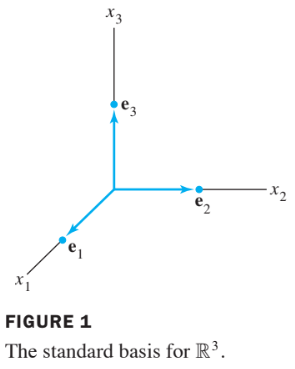Ch04 Vector Spaces
4.3 Lineary Independent Sets; Bases
An indexed set of vectors in is said to be linearly independent if the vector equation
has only the trivial solution, .
The set is said to be linearly dependent if (1) has a nontrivial solution, i.e., if there are some weights, , not all zero, such that (1) holds.
In such a case, (1) is called a linear dependence relation among .
Theorem 4:
An indexed set of two or more vectors, with , is linearly dependent if and only if some (with ) is a linear combination of the preceding vectors, .
Definition: Basis
Let be a subspace of a vector space . An indexed set of vectors in is a basis for if
- (i) is a linearly independent set, and
- (ii) The subspace spanned by coincides with ; that is, .
The definition of a basis applies to the case when , because any vector space is a subspace of itself.
Thus a basis of is a linearly independent set that spans .
When , condition (ii) includes the requirement that each of the vectors must belong to , because Span contains .
Standard Basis
Let be the columns of the matrix, .
That is,
The set is called the standard basis for .
See the following figure.

Theorem 5: The Spanning Set Theorem
Let be a set in , and let .
- (a) If one of the vectors in —say, —is a linear combination of the remaining vectors in , then the set formed from by removing still spans .
- (b) If , some subset of is a basis for .
Proof:
a.
By rearranging the list of vectors in , if necessary, we may suppose that is a linear combination of —say,
Given any in , we may write
for suitable scalars .
Substituting the expression for from (3) into (4), it is easy to see that is a linear combination
Thus spans , because was an arbitrary element of .
b.
If the original spanning set is linearly independent, then it is already a basis for .
- Otherwise, one of the vectors in depends on the others and can be deleted, by part (a).
- So long as there are two or more vectors in the spanning set, we can repeat this process until the spanning set is linearly independent and hence is a basis for .
- If the spanning set is eventually reduced to one vector, that vector will be nonzero (and hence linearly independent) because .
Exampel 7
Let and . Note that , and show that Span = Span . Then find a basis for the subsapce .
Solution
Every vector in belongs to because
- Now let be any vector in —say
- Since , we may substitute
Thus is in , so every vector in already belongs to .
We conclude that and are actually the set of vectors.
It follows that is a basis of since is linearly independent.
Example 8 :
Find a basis for Col , where
Solution
- Each nonpivot column of is a linear combination of the pivot columns.
- In fact, and .
- By the Spanning Set Theorem, we may discard and , and will still span Col .
- Let
- Since and no vector in is a linear combination of the vectors that precede it, is linearly independent. (Theorem 4).
- Thus is a basis for Col .
Theorem 6:
The pivot columns of a matrix form a basis for Col .
Proof:
- Let be the reduced echelon form of .
- The set of pivot columns of is linearly independent, for no vector in the set is a linear combination of the vectors that precede it.
- Since is row equivalent to , the pivot columns of are linearly independent as well, because any linear dependence relation among the columns of corresponds to a linear dependence relation among the columns of .
- For this reason, every nonpivot column of is a linear combination of the pivot columns of .
- Thus the nonpivot columns of may be discarded from the spanning set for Col , by the Spanning Set Theorem.
- This leaves the pivot columns of as a basis for Col .
Warning:
- The pivot columns of a matrix are evident when has been reduced only to echelon form.
- But, be careful to use the pivot columns of itself for the basis of Col .
- Row operations can change the column space of a matrix.
- The columns of an echelon form of are often not in the column space of .
Two Views of a Basis
- When the Spanning Set Theorem is used, the deletion of vectors from a spanning set must stop when the set becomes linearly independent.
- If an additional vector is deleted, it will not be a linear combination of the remaining vectors, and hence the smaller set will no longer span .
- Thus a basis is a spanning set that is as small as possible.
- A basis is also a linearly independent set that is as large as possible.
- If is a basis for , and if is enlarged by one vector-say,-from , then the new set cannot be linearly independent, because spans , and is therefore a linear combination of the elements in .